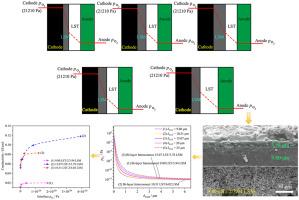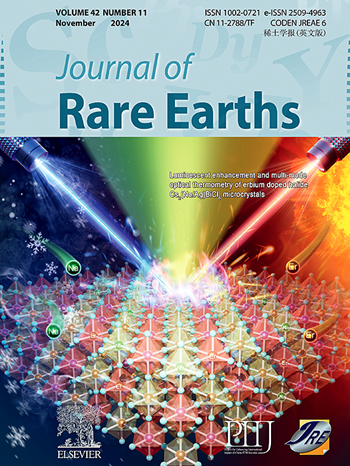Design and conductivity optimization of La0.3Sr0.7TiO3/La0.8Sr0.2MnO3 bi-layer structures as tubular segmented-in-series solid oxide fuel cell interconnect
IF 7.2
1区 化学
Q1 CHEMISTRY, APPLIED
引用次数: 0
Abstract
This study focused on meeting the stringent stability requirements of tubular segmented-in-series solid oxide fuel cells (SOFCs) in reducing and oxidizing atmospheres. To address this challenge, a bi-layer perovskite ceramic interconnect was designed by controlling the oxygen partial pressure, because of the strong correlation between the conductivity of strontium-doped lanthanum titanate (LST) and the oxygen partial pressure. The LST powder was prepared using solid-phase and sol–gel methods, and their influence on particle size and sintering behavior was compared. LST/lanthanum strontium manganite (LSM) bi-layer ceramic interconnects with varying thicknesses were fabricated through screen printing and co-sintering. The results demonstrate favorable interfacial bonding and excellent chemical compatibility between the ceramic layers. The conductivity of the bi-layer interconnect exhibits a temperature-dependent behavior, peaking at 550 °C. Simulation calculations and research findings validate that the conductivity of the bi-layer interconnect is determined by the thickness of the LSM layer and the oxygen partial pressure at the interconnect interface. Optimal conductivity is achieved with a bi-layer interconnect consisting of approximately 15 μm of LST and 4 μm of LSM. This can be attributed to the efficient regulation of oxygen partial pressure at the interface, effectively mitigating LSM decomposition caused by low oxygen partial pressure and the subsequent reduction in conductivity. These results provide valuable fundamental data and methodology for the development of high-performance interconnects for tubular segmented-in-series SOFCs.

La0.3Sr0.7TiO3/La0.8Sr0.2MnO3双层结构管状分段串联固体氧化物燃料电池互连设计及电导率优化
本研究的重点是满足管状分段串联固体氧化物燃料电池(SOFCs)在还原和氧化气氛下的严格稳定性要求。为了解决这一挑战,由于掺杂锶钛酸镧(LST)的电导率与氧分压之间存在很强的相关性,因此通过控制氧分压设计了双层钙钛矿陶瓷互连。采用固相法和溶胶-凝胶法制备LST粉末,比较了固相法和溶胶-凝胶法对LST粉末粒度和烧结性能的影响。通过丝网印刷和共烧结制备了不同厚度的LST/镧锶锰酸盐(LSM)双层陶瓷互连材料。结果表明,陶瓷层之间具有良好的界面结合和良好的化学相容性。双层互连的电导率表现出温度依赖性,在550°C时达到峰值。仿真计算和研究结果验证了双层互连的电导率由LSM层的厚度和互连界面处的氧分压决定。通过由大约15 μm LST和4 μm LSM组成的双层互连,可以实现最佳导电性。这可以归因于界面处氧分压的有效调节,有效减轻了氧分压低导致的LSM分解和随后的电导率降低。这些结果为开发管状分段串联sofc的高性能互连提供了有价值的基础数据和方法。
本文章由计算机程序翻译,如有差异,请以英文原文为准。
求助全文
约1分钟内获得全文
求助全文
来源期刊

Journal of Rare Earths
化学-应用化学
CiteScore
8.70
自引率
14.30%
发文量
374
审稿时长
1.7 months
期刊介绍:
The Journal of Rare Earths reports studies on the 17 rare earth elements. It is a unique English-language learned journal that publishes works on various aspects of basic theory and applied science in the field of rare earths (RE). The journal accepts original high-quality original research papers and review articles with inventive content, and complete experimental data. It represents high academic standards and new progress in the RE field. Due to the advantage of abundant RE resources of China, the research on RE develops very actively, and papers on the latest progress in this field emerge every year. It is not only an important resource in which technicians publish and obtain their latest research results on RE, but also an important way of reflecting the updated progress in RE research field.
The Journal of Rare Earths covers all research and application of RE rare earths including spectroscopy, luminescence and phosphors, rare earth catalysis, magnetism and magnetic materials, advanced rare earth materials, RE chemistry & hydrometallurgy, RE metallography & pyrometallurgy, RE new materials, RE solid state physics & solid state chemistry, rare earth applications, RE analysis & test, RE geology & ore dressing, etc.
 求助内容:
求助内容: 应助结果提醒方式:
应助结果提醒方式:


